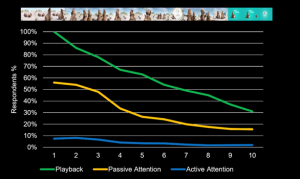
Kantar launches new attention measurement framework helping brands cut through the noise
Marketers now have quick access to facial coding to uncover how well their advertising content captures the attention of viewers on a second-by-second basis
Sydney, 16 November 2023: Kantar has announced the launch of a new proprietary attention framework. Marrying Kantar’s decades of creative evaluation expertise with the latest technology, the approach uses facial coding to uncover how well advertising content captures the attention of viewers on a second-by-second basis, an essential tool in marketers’ arsenal.
Part of the expansion of Kantar’s creative testing portfolio, the new attention framework gives advertisers a summary of an ad’s ability to capture viewers’ attention, gain a comparison to norms, and access a second-by-second trace to diagnose where attention is retained and lost.
The norms and benchmarks are built using Kantar’s expertise in measuring attention and database of 50,000 attention ad tests. The attention framework uncovers whether people pay attention to ads in different media contexts and what creative strengths drive attention, giving advertisers the insights that they need to optimise their ad to improve its ability to engage viewers. It is available in LINK+ (Kantar’s automated, self-serve or serviced solution for testing and evaluating creative) and Context Lab (Kantar’s digital media optimisation solution).
As part of the new framework, Kantar is deploying significantly improved attention measurement. The upgraded facial coding technology now includes gaze monitoring components making it more accurate than ever before. Advertisers receive measures of both active and passive attention, giving them richer and deeper understanding of how their ads will perform in context. Using privacy-safe methods, the solution measures:
- passive attention – the average time in seconds/percentage where viewers’ eyes are on-screen when the ad was visible
- active attention – the seconds/percentage of time where viewers’ facial expressions indicate emotional engagement with the content.

Second-by-second trace illustrating passive and active attention retention during playback
Ted Prince, Global Chief Product Officer at Kantar says, “the race for attention is one of the defining challenges of our time for modern marketers”.
“How to capture the attention of viewers amid the myriad of distractions is something that keeps many awake at night. At Kantar, we are using the latest technology in combination with our decades of expertise to tackle these thorny questions. With digital ad spend continuing to rise, it is key that marketers understand how their creative will perform in digital channels. The era of repurposing a TV ad and hoping for the best is over.”
Kantar Australia Head of Media Sharon Hilton adds that “attention is a big topic of conversation in Australia as local marketers continue to grapple with ensuring that campaigns cut through”.
“Our 2023 Australian Media Reactions study found that the attention economy was in the top three list of priorities for marketers in 2024 with 41 per cent stating it was a key priority. Almost half of marketers say that attention is an important industry debate (47 per cent) and nearly three in five said that channels where consumers pay more attention was the key factor influencing how to allocate media budget (58 per cent).”
“We are pleased to be bringing in this world leading technology to measure attention into our testing portfolio for Australian clients. This development gives Australian marketers much needed insight into the attention that their ads are generating in different contexts and importantly takes the attention measurement a step forward by exploring the relationship between attention and marketer outcomes.”
Kantar Australia Head of Creative Irene Joshy adds that “the content maze that we live in has amplified the problem of ‘selective’ attention”.
“Selective attention impacts creative effectiveness adversely. To help marketers navigate this, the development of this new attention metric built into in-context digital testing is revolutionising the way that we measure the relationship between playback, attention and engagement to drive stronger digital ROMI.”
-ends-
For more information or interviews, please email: jeannie.duhigg@kantar.com
About Kantar
Kantar is the world’s leading marketing data and analytics business and an indispensable brand partner to the world’s top companies, including 96 of the world’s 100 biggest advertisers. We combine the most meaningful attitudinal and behavioural data with deep expertise and technology platforms to track how people think and act. We help clients develop the marketing strategies that shape their future and deliver sustainable growth. www.kantaraustralia.com
About Link+
Built using the largest scientifically based normative creative database in the world with over 250,000 ads, LINK+ on Kantar Marketplace provides tailored creative insights and validated creative effectiveness metrics and is proven to accurately predict an ad’s ability to generate impact and sales. Digital ads with high creative quality are proven to produce up to 2.5 times sales uplift compared to those with low creative quality.
Discover Link+.
About Context Lab
Context Lab allows marketers to understand the effectiveness of content in specific digital contexts before a campaign goes live. They can assess paid digital media in a variety of platforms, as well as influencer content, branded content and native marketing. Early learning about which creative works best in which context enables marketers to optimise placements and improve digital campaign performance.
Discover Context Lab.

